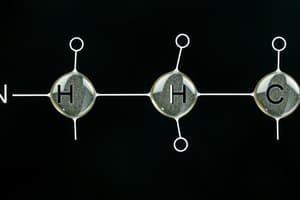Podcast
Questions and Answers
Match the following organic reactions with their corresponding examples:
Match the following organic reactions with their corresponding examples:
Addition Reaction = Reaction of formaldehyde with cyanide ion Substitution Reaction = Hydrolysis of tert-butyl chloride Elimination Reaction = Dehydration of ethanol Oxidation Reaction = Oxidation of ethanol to acetic acid
Match the following organic reaction types with their respective descriptions:
Match the following organic reaction types with their respective descriptions:
Nucleophilic Substitution = A reaction involving an electron-rich species attacking a positively charged center Electrophilic Addition = An electron-deficient species adding across a double or triple bond Rearrangement Reaction = Conversion of a molecule into an isomer Free Radical Addition = A reaction involving species with unpaired electrons
Match the following organic reactions with the key feature that defines them:
Match the following organic reactions with the key feature that defines them:
Polymerization = Joining of small molecules (monomers) to form a large molecule (polymer) Hydrolysis = Breaking of a bond in a molecule by reaction with water Combustion = Reaction with oxygen leading to carbon dioxide, water, and energy release Isomerization = Conversion of a molecule into its isomer
Match the following organic reactions with their corresponding mechanisms:
Match the following organic reactions with their corresponding mechanisms:
Match the following organic reactions with their respective products:
Match the following organic reactions with their respective products:
Match the following organic reactions with their corresponding reactants:
Match the following organic reactions with their corresponding reactants:
Match the following organic reaction types with their corresponding characteristics:
Match the following organic reaction types with their corresponding characteristics:
Match the following organic reaction types with their corresponding reagents:
Match the following organic reaction types with their corresponding reagents:
Match the following organic reactions with their corresponding conditions or catalysts:
Match the following organic reactions with their corresponding conditions or catalysts:
Match the following types of reactions with their correct descriptions:
Match the following types of reactions with their correct descriptions:
Match the specific types of substitution reactions with their characteristics:
Match the specific types of substitution reactions with their characteristics:
Match the following addition reaction types with their examples:
Match the following addition reaction types with their examples:
Match the following elimination reaction types with their corresponding definitions:
Match the following elimination reaction types with their corresponding definitions:
Match the following categories of condensation reactions with their examples:
Match the following categories of condensation reactions with their examples:
Match the types of pericyclic reactions with their characteristics:
Match the types of pericyclic reactions with their characteristics:
Match the following oxidation and reduction types with their examples:
Match the following oxidation and reduction types with their examples:
Match the processes involved in radical reactions with their definitions:
Match the processes involved in radical reactions with their definitions:
Flashcards
Substitution Reaction
Substitution Reaction
A type of chemical reaction where one atom or group of atoms in a molecule is replaced by another atom or group.
Nucleophilic Substitution
Nucleophilic Substitution
A reaction in which a nucleophile (an electron-rich species) replaces a leaving group (a group that departs with its electrons).
SN1
SN1
A substitution reaction that involves the formation of a carbocation intermediate.
SN2
SN2
Signup and view all the flashcards
Electrophilic Substitution
Electrophilic Substitution
Signup and view all the flashcards
Addition Reaction
Addition Reaction
Signup and view all the flashcards
Condensation Reaction
Condensation Reaction
Signup and view all the flashcards
Pericyclic Reactions
Pericyclic Reactions
Signup and view all the flashcards
Elimination Reaction
Elimination Reaction
Signup and view all the flashcards
Rearrangement Reaction
Rearrangement Reaction
Signup and view all the flashcards
Oxidation Reaction
Oxidation Reaction
Signup and view all the flashcards
Reduction Reaction
Reduction Reaction
Signup and view all the flashcards
Radical Reactions
Radical Reactions
Signup and view all the flashcards
Polymerization Reaction
Polymerization Reaction
Signup and view all the flashcards
Study Notes
Organic Chemistry Reaction Types
- Substitution Reactions: One atom or group is replaced by another.
- Nucleophilic Substitution: A nucleophile replaces a leaving group.
- SN1: Unimolecular, involving a carbocation intermediate.
- SN2: Bimolecular, involving a concerted mechanism.
- Electrophilic Substitution: An electrophile replaces a group, common in aromatic compounds.
- Examples include nitration, sulfonation, and halogenation of benzene.
- Nucleophilic Substitution: A nucleophile replaces a leaving group.
Addition Reactions
- Atoms are added to a double or triple bond, reducing unsaturation.
- Electrophilic Addition: Electrophiles add to alkenes or alkynes.
- Examples include hydrohalogenation and hydration.
- Nucleophilic Addition: Nucleophiles add to carbonyl compounds (aldehydes or ketones).
- Free Radical Addition: Radicals add to unsaturated compounds, e.g., polymerization of ethene.
- Electrophilic Addition: Electrophiles add to alkenes or alkynes.
Elimination Reactions
- Atoms or groups are removed from a molecule, forming a double or triple bond.
- E1: Unimolecular, involving a carbocation intermediate.
- E2: Bimolecular, involving a concerted mechanism.
- Example: Dehydration of alcohols and dehydrohalogenation.
Rearrangement Reactions
- Atoms within a molecule rearrange to form structural isomers.
- Examples include Pinacol-Pinacolone and Wagner-Meerwein rearrangements.
Redox Reactions
- Involve electron transfer, leading to oxidation or reduction.
- Oxidation: Increasing the number of bonds to oxygen or decreasing the number of bonds to hydrogen.
- Reduction: Increasing the number of bonds to hydrogen or decreasing the number of bonds to oxygen.
- Examples include alcohol oxidation and alkene hydrogenation.
Condensation Reactions
- Two molecules combine to form a larger molecule, often with the elimination of a small molecule like water.
- Examples: Aldol condensation and esterification.
Pericyclic Reactions
- Reactions proceed via a cyclic transition state.
- Types include cycloadditions (e.g. Diels-Alder reaction), sigmatropic rearrangements, and electrocyclic reactions.
Radical Reactions
- Involve free radicals as intermediates having unpaired electrons.
- Steps: Initiation, propagation, and termination.
- Examples include halogenation of alkanes and polymerization.
Polymerization Reactions
- Small molecules (monomers) combine to form large macromolecules (polymers).
- Addition Polymerization: No by-products, like polyethylene from ethene.
- Condensation Polymerization: By-product elimination, like nylon formation.
Hydrolysis Reactions
- Breaking of a bond in a molecule due to reaction with water.
- Examples include hydrolysis of esters and amides.
Combustion Reactions
- Organic compounds react with oxygen to form carbon dioxide, water, and energy.
- Example: Combustion of hydrocarbons.
Isomerization Reactions
- Molecules convert to isomers, changing atom arrangement without changing molecular formula.
- Example: Conversion of glucose to fructose.
Carbenoid Reactions
- Reactions involving carbene or carbene-like intermediates.
- Example: Simmons-Smith cyclopropanation.
Studying That Suits You
Use AI to generate personalized quizzes and flashcards to suit your learning preferences.




